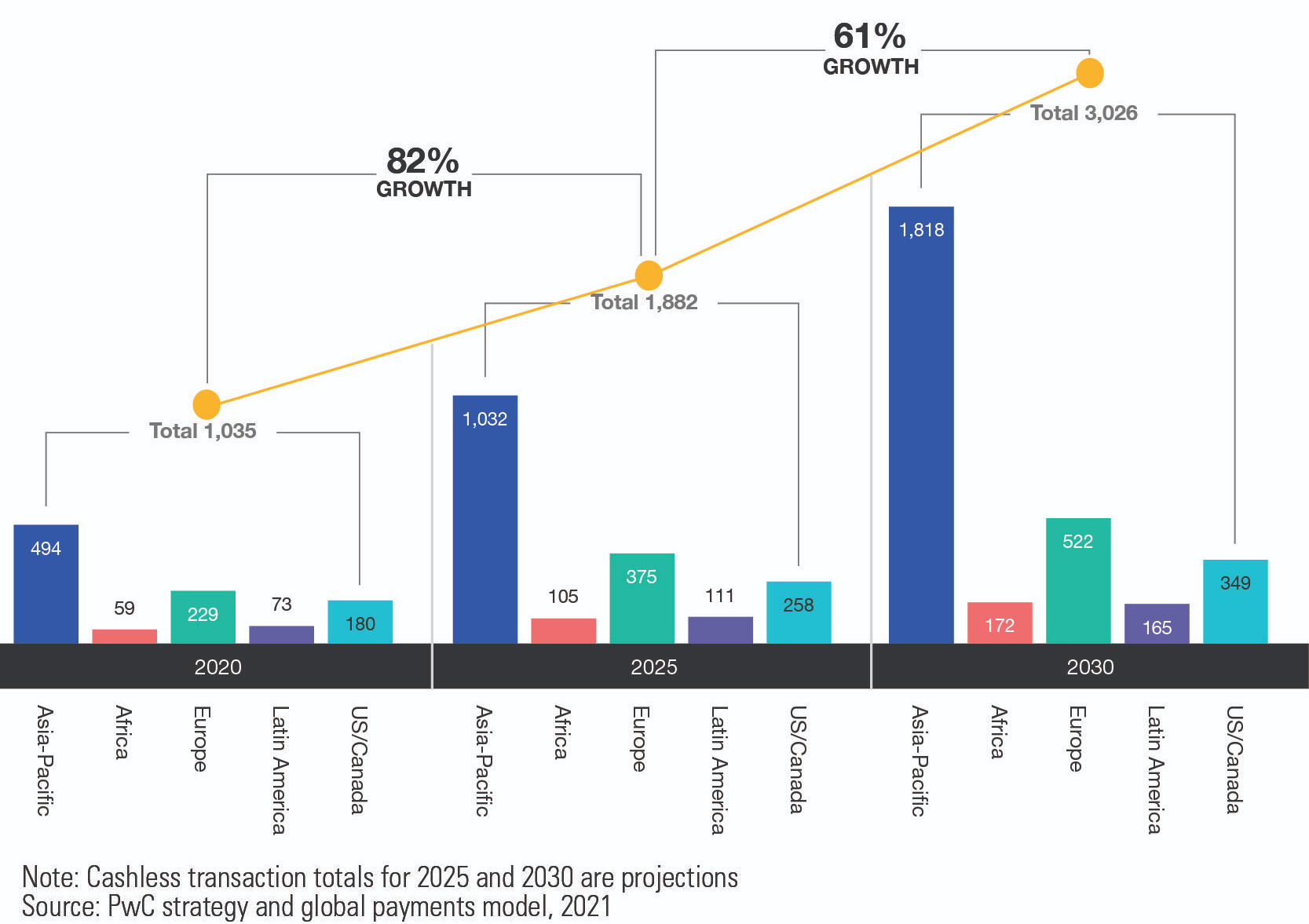Technology is rapidly transforming Asia’s payments landscape, with a dizzying array of online transaction methods replacing cash.
According to PricewaterhouseCoopers (PwC), cashless transactions will reach 1.9 trillion globally in 2025. Asia-Pacific will continue to account for the biggest share, with volume doubling to more than one trillion compared to 2020. Europe, the second largest cashless continent, will only achieve a third of APAC’s performance.
Cashless transactions will more than double by 2030
Electronic payment transactions, including via digital wallet, credit card and debit card, have already outnumbered cash settlements in the APAC region, according to fintech service provider FIS Global. But while the convenience of cashless transactions has led many markets to follow the trend, some economies in the region are still clinging to cash. Around half of the transactions in Thailand, Japan and Vietnam are settled in cash, making them the top three cash-based economies in the region, while in China and Australia, cash payments only account for less than 10%, FIS research finds.
Japan, one of the world’s largest markets, is known for its cutting-edge technology in manufacturing. However, the lack of hands-on technological knowledge nationwide, especially among the senior population, is one reason for its restricted access to online transactions. While the country boosted cashless payments by 1.4 times in the past decade to 36% in 2022, its share is inferior to that of neighbours. The proportion of cashless deals in South Korea, for example, was twice that of Japan in 2021.
Japan continues to move ahead in its digitalization, however, with code payments rising to 2.6% in 2022 from 0.1% in 2018. Credit card use is also widespread, and remains the predominant means of cashless transaction in the country. Its huge population makes it the second-largest e-commerce market in the region valued at US$200 billion, according to FIS.
Tech gap in Thailand
In Thailand, there is a gap in payment habits between big cities and rural communities. Research conducted by London-based YouGov this year indicated that 55% of customers from the Bangkok Metropolitan Region prefer using e-wallets for online shopping. Reliance on cash increases the farther away from urban areas, with more than half of online shoppers from the northern and southern regions opting to pay in cash when the goods arrive at their doorstep.
According to a 2021 survey by Bank of Thailand, both retailers and buyers preferred coins and notes to other payment methods. Another study, conducted by Visa last year, showed that the majority of Thais favoured digital transactions which they deemed safer than cash.
Vietnam in top gear
The number of digital transactions is soaring in Vietnam, although the upward trend is still at an early stage as it was an entirely cash society only a few years ago. According to the government think tank Central Institute for Economic Management, the ratio of cashless transactions in the country stood at just 11.49% in 2019, two years after the government set an ambitious target to reduce the ratio of cash payments to less than 10% in 2020.
Thanks to health restrictions during the pandemic, along with government initiatives to promote digital payments such as the annual Cashless Day which started four years ago, the proportion of citizens with bank accounts jumped from 30.8% in 2019 to more than 60% in the first six months in 2022.
The government now targets 50% of cashless transactions in e-commerce and 80% of people older than 15 with bank accounts before 2025.
Asian countries are at different stages and paces of digital payments development but are all moving towards a cashless society by integrating technology into their daily activities.
In the Asean region, governments are already developing cross-border payment solutions. Vietnam recently joined Indonesia, Malaysia, Thailand, the Philippines and Singapore in a QR code network that brings retailers and consumers from the six countries together in a system that can increase the volume of transactions from 13 billion this year to 90 billion in 2028, according to Juniper Research. This is a huge opportunity for countries in the region to accelerate their economic growth.











